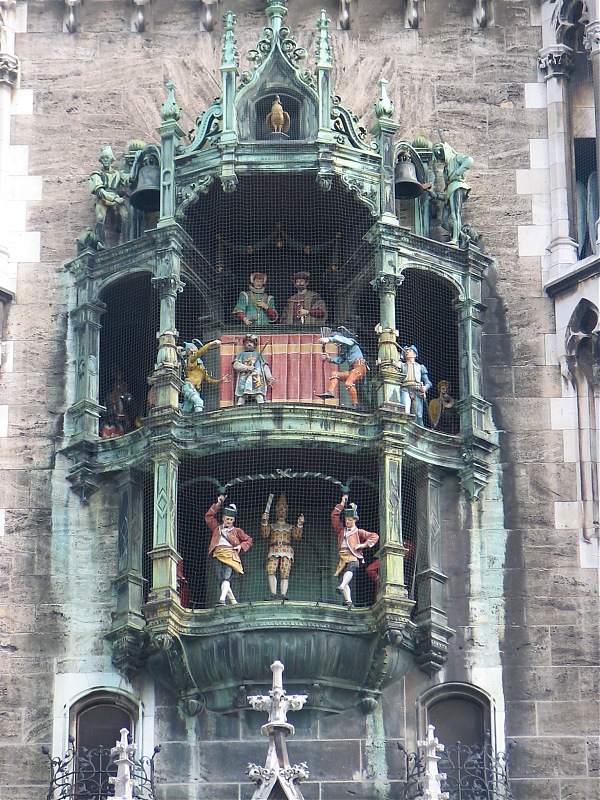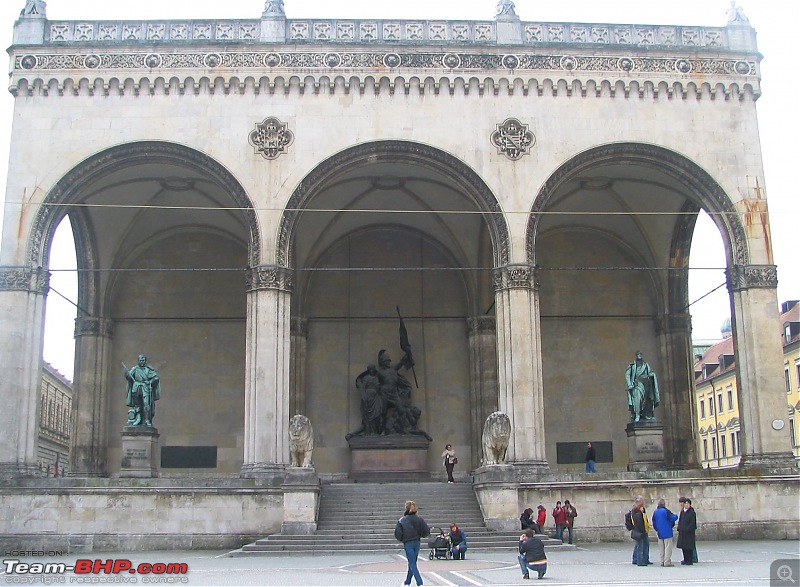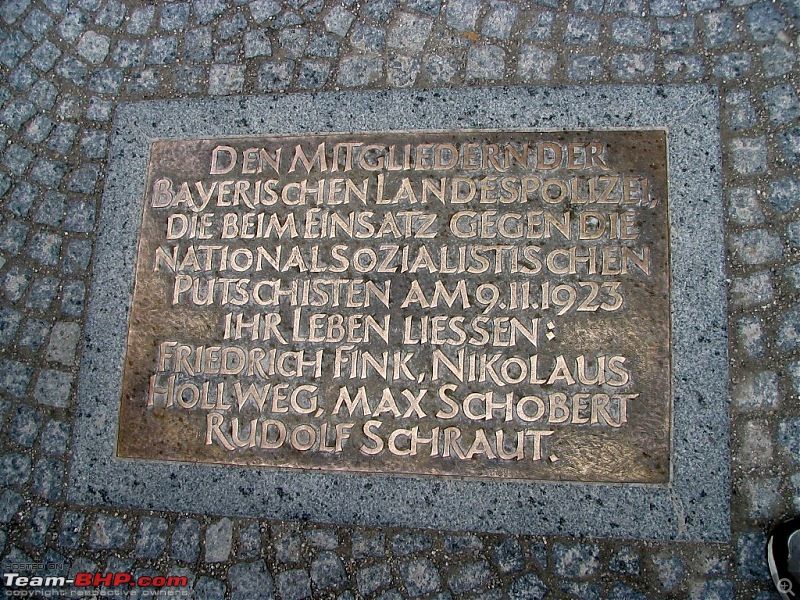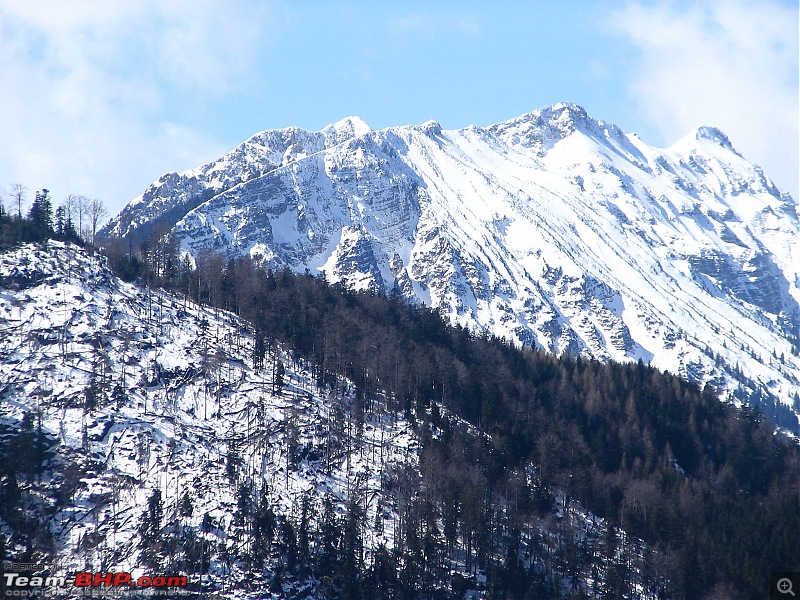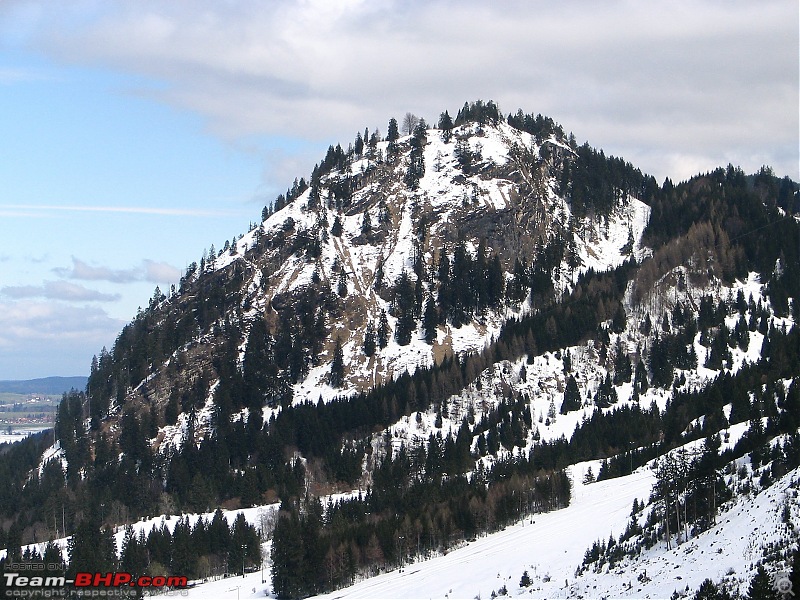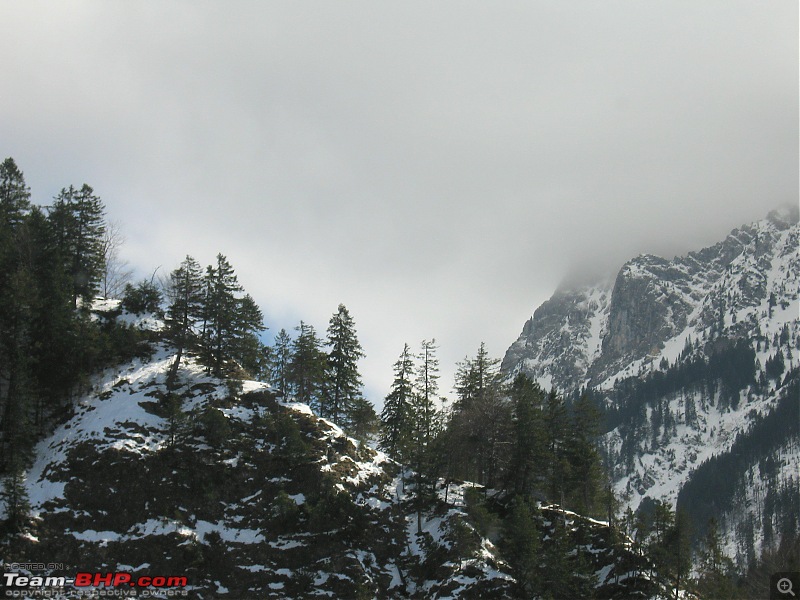| |||||||
| Search Forums |
| Advanced Search |
| Go to Page... |
 |
| Search this Thread |  9,924 views |
| | #1 |
| BHPian Join Date: Aug 2009 Location: New Delhi
Posts: 381
Thanked: 188 Times
| An Old Travelogue - Germany 2006 Hello Folks, I am back with yet another, old travel tale. This time to the much discussed land on the forum - Germany. Easter vacation 2006 was the time I went to Germany. The thread recounts some of the experiences during that trip. Hope u all had a nice Easter!!  Lalit Last edited by lsp : 6th April 2010 at 16:25. |
| |  ()
Thanks ()
Thanks
 |
| |
| | #2 |
| BHPian Join Date: Aug 2009 Location: New Delhi
Posts: 381
Thanked: 188 Times
| München: Tag Eins (Part 1) München: Tag Eins (Part 1) We started of (D & me) from Aalborg, Denmark at around 5 pm to Odense, Denmark from where we would take the Intercity till Munich, Germnay. Only one change - not bad. Now a word of caution about my travelmate D. He is one person, who if says "We should walk left to find the place", then without wasting a second, you should walk right and you'll be spot-on at your destination. I trusted him with finding the platform for boarding the train and went and waited for the train while all this time the train which we were supposed to be travelling in was behind our back. Thanks to the tall blonde chick with awesome legs who walked past and while my gaze was following her I happened to spot the train in which we were supposed to travel. Anyways, after a dash to hop in the train and a flurry of choicest expletives (to D with love), we were both seated. Wow what a beginning to the travel. I solemnly vowed to cut down on the adventure in the trip and hence relieve D from all such duties during the entire trip. We reached Munich, the capital of the southern state of Bavaria, around 9 am and the first thing we did (after grabbing a sandwich each) was visited the office of Radius Tours to get their iternary of tours. There was one at 10 am which was the walking tour of Munich. We quickly left for our hotel which was about 5 mins from the main train station - Hauptbahnhof. We were back at the station to begin our tour at 10 am. Incidentlly, we were the only two people who took the tour, which kinda raised a few questions in my mind. Our guide Robert, was an American from Texas who had been in Germany for about 6 years now. We kicked off the tour from Marienplatz (pic above). Marienplatz is Munich's central square and is dominated by the impressively ornate New Town Hall (Neues Rathaus). The town hall is 79 meters high and was built between 1867 and 1909 by Georg Joseph Hauberrisser in Flemish Gothic style. On the walls of the rathaus are small and big figures of dragons rats, gorgoyles which are basically to ward of evil and as a protection against the plague which knocked off half of Munich's population in the early 17th century. The rat figures on the walls do tend to make one think that Rathaus means Rat House. On the Neues Rathaus is the Glockenspiel (pic above). Life size figurines which come out n dance everyday at 11 am (and sometime in the evening too I guess). The first level figurines are dancing for the occasion of the marriage of some Duke/King, I dont remember the name. After a while two knights on horses come out and joust each other. The Blue knight is Bavarian and the Red one is Austrian. There was clapping when the blue knight jousted out the red one. On the second level are the barrel makers who came out and danced when the plague got over. When the music stops most people disperse but this is not the end of the Glockenspiel ritual. Not until the rooster crows. Right in the middle of the square is Mariensäule (pic above), a great column topped by a golden Virgin Mary, and surrounded on four corners by beast slaying little cherubs. It was erected in 1638 by the Elector Maximilian I after Munich was occupied by the Swedes during the Thirty Years' War. Now one of the cherubs is killing a snake and reportedly the snake represents Protestants. In the Middle Ages, the square used to be a market place as well as the place where tournaments and festivities took place. but once they put up the golden Mary they shifted the market from here. On the east of the Neues Rathaus is the Altes Rathaus (Old Town Hall). The original Old Town Hall was completely destroyed by fire in 1460. Between 1470 and 1480, the old town hall was rebuilt in Gothic style by Jörg von Halsbach, who was also responsible for the Frauenkirche. It was completely destroyed again during the IInd world war, but rebuilt afterwards. The last part, the tower, was completely rebuilt in 1972 so it won't be surprising that one may take the building for a regular building and miss it. The square is also overlooked by the twin spires of the Frauenkirche (pic above). The building measures 109 meters high and is only 40 meters wide. Its distinctive domes, which were built in 1525 would serve as a model for many of Bavaria's towers. Now a folklore which goes with this monument is that, Munich didn't have a bishop and in order to get one, it was decided that they will build a cathedral and then ask the Holy Roman Emperor for one. Now the cathedral had to be built quick. Legend says that the architect Jörg von Halsbach struck a deal with the Devil that, the Devil will not obstruct the construction of the place and in turn the architect promised that there will be no windows in the building. The whole building took about 20 years, which is remarkably fast if u keep in mind that most cathedrals will take about 3 generations. The reason was that the building is made of bricks and not marble or granite or any other stone. Anyhow, all set and done, the place got finished and the Devil came to inspect it. The architect asked devil to stand at one place and view the building. No windows indeed. Amazing!! And as the devil took another step all the windows became visible to him. He got so pissed off that he stomped his foot on the ground and that footprint is still there. If you keep your right foot on the imprint then you are at the position from where you can't see a single window (on the sides). And sometime later Munich got an archbishop. The current Pope Benedict XVI, was an archbishop here. The building on the exterior is mostly simple and the original Gothic interior has been destroyed n restore many a times. One of the most interesting things inside the church is the grave of Prince Elector Kurfürst Maximilian I. The twin onion shaped spires of the cathedral are the tallest thing in the city and as a rule, no building in Munich can be taller than 109 meters, which is the height of the spires. The gold statue of The Virgin Mary, Mariensäule, was earlier placed here. To the south east of the Marienplatz is the towering spire of the Peterskirche(pic above). St. Peter's is the city's oldest church, although nothing remains from the original built in 1368. Alter Peter has been rebuilt so many times that now there are layers and traces of Gothic, Baroque and Rococo style. The interior is full of interesting altars and an amazing ceiling. The mural on the ceiling is simply gorgeous. The church also contains the gilt-covered and gem-studded skeleton of St. Mundita. From its resting place on a cushion, it stares at you with two false eyes in its skull and jewels covering the mouth and rotten teeth. Quite scary, I would say. She is supposed to be the patron saint of single women and on her day if you are a woman and you come & pray to her then you will find a man, subject to the condition that your prayers are answered. So ladies if u r single n looking u know where to go. I asked my guide if there was a patron saint of single men. He didnt know.... HMPH!!! For 1.5 Euros you can walk up the 302 steps of the spire and have an amazing view of the city from a height of 92 meters. Thx, but no thx :-) A little beyond the St Peter's is the Viktualienmarkt. It opened as a small herb market in 1807 and over the past 200 years, it has developed into one of the city's biggest attractions. Here one can buy exotic n local fruits, vegetables, all kinds of cheeses, meats and other foodstuffs from all pver the world. Its a bit expensive for regular grocery shopping. Of course there's also a Biergarten (Beer garden), and I am told its the only one in town which can sell beer from all the 6 breweries in Bavaria, 40000 litres from one and then they move to the next brewery and so on. It has a maypole in the center. Tradition goes that if during the Oktoberfest the neighbouring villagers manage to steal your maypole and erect it next to theirs in their village then you ought to pay for all their beer in the next years fest. Phew.. that took a while. Munich - One down , one to go. Last edited by lsp : 6th April 2010 at 16:49. |
| |  ()
Thanks ()
Thanks
 |
| | #3 |
| BHPian Join Date: Aug 2009 Location: New Delhi
Posts: 381
Thanked: 188 Times
| München: Tag Eins (Part II) Day 1 cont.After visiting all the places mentioned in the previous post, we sat down at Mc Donalds to grab a bite. Turns out this Mc is owned by desi people and that too from Delhi - 'My city'. That must have been the exact sentiment in the owner's heart as well, for he offered us free meals, which we declined politely, but then he insisted on giving us free icecream. We couldn't resist that much, and like all Indians we talked about Cricket - India's performance against England, and all this happened while we were at the counter, with a pile of people forming behind us. Aakhir dil hain Hindustani. Odeonsplatz is situated at the start or end of Ludwigstrasse, which is also known as the "German Champs Elysees". Munich has varying styles of architecture and in Odeonsplatz you can find shades of Italian styles. It has a tri-arched platform for a statue of Ludwig himself. This square is flanked on the left by the big yellow church Theatinerkirche and on the right is the Residenz. Now if u notice in the pic below, the two lions at Odeonsplatz, the one on your left has its mouth open unlike the one on the right. It represents the sentiment that Bavaraia can always speak against the ruler but it will never speak against the religion (remember Left - Theatinerkirche, Right - Residenz) :-) The square is most famous for Adolf Hitler’s Beer Hall Putsch on November 8 and 9 of 1923 . Following a long night of agitation the revolutionaries were parading toward the Ministry of War on Schönfeldstrasse on the morning of the 9th when they were confronted with a police barricade spread out across Odeonsplatz. Sixteen persons (15 Nazis and a waiter) and four police officers were killed in the subsequent riots and once the Nazis came to power, in 1933, the square became a kind of shrine to the fallen Nazi “martyrs.”. National Socialist flags covered the place and a small monument/plaque was set up on its right wall. All passers-by were required to do the Nazi salute when passing by it or face arrest. Just across the street are two bronze lions which guard the gates of the Residenz. Rubbing the noses of the lions is considered a good luck charm, so I duly rubbed their noses. One reminiscent of those times is the metal plate in front of the platz. "Den Mitgliedern der Bayerischen Landespolizei, Die Beim Einsatz gegen die Nationalsozialistischen Putschisten am 9.11.1923 Ihr Leben liessen: Friedrich Fink, Nikolaus Hollweg, Max Schobert, Rudolf Schraut". When translated it reads - "Remains of the police personal who died fighting the National Socialitic Movement on 9.11.1923 are buried here. Friedrich Fink, Nikolaus Hollweg, Max Schobert, Rudolf Schraut" OK now going to the Residenz to the right of the square. The Residenz was the official home of the Dukes and Duchesses of Bavaria for centuries, from its creation in 1385 to their abdication and Bavaria's induction into the Weimar Republic in 1918. Today it is a museum with over 10 courtyards n 130 rooms...I didnt go inside so cant comment much about that part.. but a stroll around that place was delightful. The Residenz grew over the centuries and assembles the styles of the late Renaissance, as well as of Baroque, Rococo and Classicism. If you see the pic below you might notice that the round windows towards the top on the right side wall are painted and not real. DAMN, I heard the term for this style somewhere but it's slipping my mind. Another story here - King Ludwig I of Bavaria fell for the charms of an Irish dancer Lola Montez. Now Lola was a very clever and progressive lady, that is to say she slept around a lot. She quickly began to use her influence on the king and this made her unpopular with the local population, particularly after documents showing that she was hoping to become a naturalised Bavarian citizen and be elevated to the nobility were made public. From here arose the expression "Whatever Lola wants, Lola gets". The Hofgarten with the dome of the state chancellery near the Residenz is also a sight to watch and a stroll is a good idea anytime of the day. Adjoining the gardens is the Bavarian State Parliament. Some parts of the building were completely destroyed during the World War II and had to built again like the glass structure. A closer look and you might notice the signs of World War II bombardment on the huge pillars. I tell you, if just standing there sent the shivers down my spine, imagine how it would be when this whole thing happened. A stone throw from there is the World War Memorial. Now usually the memorials are built at an altar, but this is actually below ground level, the earth was dug up, which symbolizes that they aren't really proud of the events. Beneath this memorial is the grave of the unknown soldier. The White Rose Memorial is also close by. Hofbräuhaus (The Royal Brewery) - It is one of the five major beerhalls in the city, but probably the most famous. It is at places such as these that hundreds or even thousands of people gather during the evenings, drink beer out of stone jugs and talk about everything under the sun. It was infact a beerhall, Bürgerbräukeller, from where the Beer Hall Putsch started. Bürgerbräukeller was also the hall where an assasination attempt on Hitler failed. DAMN!!! Hofbräuhaus is made up of several large rooms with long wooden tables, and a large outdoor courtyard in the back. Dig into some humungous warm pretzels and the popular 1-litre steins. This place hosted a rally run by none other than Hitler himself. Even the Hofbräuhaus wasnt spared the catastrophe of World War II. On the night of April 25, 1944, the first airborne bombs struck the it and three subsequent air raids almost completely destroyed the building. The pic above shows the lid of a barrel. The beerhall has beautifully decorated cielings with paintings all over. If u enter and look directly above and a little to your left then you will see a painting which consists of 4 Bavarian flags and 4 Bavarian coats of arms arranged in an atypical way. On close inspection one would notice that the Flags n Coats of Arms are painted in such a way that they give an appearance of Hakenkreuz (Swastika), and mind you public display of such Nazi symbols is illegal and punishable. This is where the symbologist streak in me comes alive :-)) BTW Munich hosts the biggest beer fair in the world – the traditional Oktoberfest, which happens in the last week of September. In 1810 Max Joseph arranged a grand festival to mark the wedding of his son, crown prince Ludwig, to Therese Charlotte Luise, Princess of Saxony-Hildburghausen. This was the first Oktoberfest and each year it only gets better. Königsplatz is one of the most impressive squares in Munich is the Königsplatz. Its HUGE. It was once a major staging ground for Hitler to flaunt his military parades. Flanked by three neo-classic temples, this square had been nicknamed Athens on the Isar. The structure now houses several museums and many classes are conducted here. The office which Hitler once used is reported now being used for music classes. Olympiapark & Olympiastadion - The sports complex was created specially for the 1972 Summer Olympics. The stadium (with interesting canopy roof) and the 290m broadcasting tower are now established city landmarks. It has a big green area with hills and a lake. You could take the elevater to the Olympiaturm (Olympia Tower) and have an awesome view over the whole city. In the Summer of 1972 Munich hosted "The Happy Games", an Olympics intended to showcase a new peaceful, democratic Germany. On 5th September a group of Palestinians broke into the Olympic Village and entered the accommodation of the Israeli athletes at 31 Connollystrasse, killing two and capturing nine. A tragedy which hasn't been forgotten by the world. Earlier this used to be the stadium to host all matches for Bayern Munich, which is one of the best football clubs in Europe, but now the games have shifted to Alliance Arena. In the vicinity of the Stadium is the Office n museum of Bayerische Motoren Werke (BMW). |
| |  ()
Thanks ()
Thanks
 |
| | #5 |
| BHPian Join Date: Aug 2009 Location: New Delhi
Posts: 381
Thanked: 188 Times
| |
| |  ()
Thanks ()
Thanks
 |
| | #6 |
| BHPian Join Date: Aug 2009 Location: New Delhi
Posts: 381
Thanked: 188 Times
| Well the next day was reserved for the Schloss Hohenschwangau and Neuschwanstein. The two castles are near a place called Füssen which is about 2 hours from Munich. A travel tip here - In Munich when u buy a 1+1 ticket its actually valid for 5 people so it makes sense to go there in a group of 5 and make use of this scheme. Just outside the Füssen station (pic above) you will find the busses which will take you to the summit, for less than 4 euros, from where you can get the tickets to the castles. Now a twin ticket for both the castles costs less (15 Euros approx) so go for it. Now you could take a Bus, a horse driven carriage or simply walk to the castles. The day I was there, the buses were not plying so there was a huge waiting line for the carriages therefore chose to walk. First to the Schloss Hohenschwangau. Well there would be a guided tour in English of the castle which comes included in the tickets u buy for the entry. Schloss Hohenschwangau (Castle of the High Swan County) was the childhood residence of King Ludwig II of Bavaria and was built by his father, King Maximilian II of Bavaria. The castle is small, nothing like the fabulous castles you have back home... and the size of the rooms is such that u have to remind yourself time n again that u r in a castle.. the exterior is yellow and at many places repair works are also being carried out. It is said that Crown Prince Maximilian of Bavaria discovered the ruins of Burg Schwanstein while out walking in the Bavarian countryside one day and vowed to restore the castle into a romantic royal residence. Many rooms here such as the Knight's Hall, Billiard's room, Hall of the Knight of the Swan (which was the formal dining hall) Some pics of the interiors can be found here. Next we moved to the Schloss Neuschwanstein whose construction was started by King Ludwig II of Bavaria, also known as "Mad King Ludwig". It was named after the Swan Knight, Lohengrin, of Wagner's opera, and was designed by Christian Jank. Now one interesting thing to note is that reportedly King Ludwig was very pally with this guy Wagnar and most rooms in this castle are based around a theme of one of his operas. Many tapestries and paintings also depict scenes from the operas of Richard Wagner, a reflection of Ludwig's love for Wagner's work. However, many of the interior rooms remain undecorated; only 14 rooms were finished before Ludwig's death. Owing to his eccentricites and his perceived use of Bavarian funds (a myth, as Ludwig actually used his own money to finance the construction of the castle), Ludwig was removed from power before the castle was completed. Many in the castle which are incomplete are not open to the public. This castle is supposed to have inspired the Disney castle in Paris. The Throne Hall has a huge chandelier in the shape of a royal crown and depicts the legend of Parzival on some of the walls. The chandelier reportedly weighs 3 tonnes. There are also images of six European rulers and a very beautiful mural of Christ above the kings over the throne area. The only thing missing from this room is the throne itself. The King's bedroom is the only room designed in the gothic style. The wood carvings on the bed and canopy are amazing. There is also a secret door that blends right into the wall to Ludwig's bathroom. The last room on the tour and the one at the top of the castle is the Minstrels Hall. This was designed so Ludwig could have his own private showings of his favorite operas and plays. The swan features prominently in designs motifs and paintings in both the castles. The reason being that the swan is a legendary bird and a symbol of royalty and knighthood. The visit would have been incomplete without a visit to the Mariensbruke, but we were disappointed to see that the path to the bridge had been closed coz of snow. What the Hell.. we still decided to visit it... and we were not alone.. there were scores of people there who thought alike...Some really lovely views from the bridge... absolutely amazing.. perfect postcards!! Now between all that walking from one castle to the another n then to the bridge I did manage to click some pics of the Alps. Here they are:- Back to Munich by 8 pm and we had dinner at an Indian restaurant, with this desi couple we met at the castles - Shashank & Reema. Now, I wonder why, every European city which I have visited till now always has an Indian Restaurant named 'Taj Mahal'. I mean, doesn't anything else symbolise India. Don't get me wrong, Taj is beautiful no doubt, but don't you think it is a bit overrated? First off, its not a mahal, it's a mausoleum and as for being the symbol of love, Mumtaz died giving birth to their 14th child. Some love, I must say. Last edited by lsp : 8th April 2010 at 23:26. |
| |  (1)
Thanks (1)
Thanks
 |
| The following BHPian Thanks lsp for this useful post: | driverace |
| | #7 |
| Team-BHP Support  | The castle snap really looks straight out of a Dracula flick! Very nice. Pristine location and a beautiful azure sky. |
| |  ()
Thanks ()
Thanks
 |
 |




